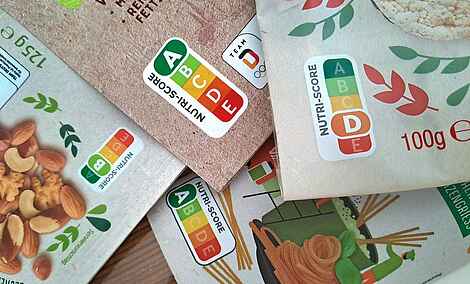Food-induced diseases such as obesity, diabetes mellitus type 2 and cardiovascular disease have been increasing globally for years. This is closely correlated with the rising consumption of highly-processed foods containing large amounts of salt, fat, sugar and additives. The rationale for introducing the Nutri-Score in France in 2017 was to provide guidance amongst the variety of products [1]. The five-level traffic light system with letters and colours shown on the packaging[1] is intended to give the consumer an overview of the ingredients and composition of the food, so contributing to a balanced diet. The more fibre, protein, pulses, fruit and vegetables in a product, the greener the traffic light. Sugar, salt, saturated fatty acids and a high total energy content, on the other hand, are indicated by an orange or red traffic light. For comparability, only foods in the same food group are compared with each other, so that ready-made pizza is compared with ready-made pizza and not with orange juice. Under this evaluation system, high quality plant oils such as olive and walnut oils were initially labelled with a yellow C due to their fat content, in other words an average assessment, although they are high in healthy unsaturated fatty acids. Using the new calculation algorithm, oils are now grouped in the same category as nuts and seeds. The content of saturated and unsaturated fatty acids and their relative proportions are now given more importance, leading to a green traffic light colour [1]. However, there is still no distinction made in the growing quality so that, for example, neither a higher content of anti-inflammatory polyphenols in organic products – such as olive oil [2] – nor sustainable production methods are included in the assessment. Important aspects in other foods, such as the use of flavourings and additives, are also not taken into account. Only sweeteners in drinks are given a negative weighting. The regrouping of foods also continues to cause ambiguities, such as the new assignment of milk, milk drinks and plant-based drinks to the drinks group. This raises the question of the extent to which milk from biodynamic production can be compared with conventionally produced juice, and whether milk can be counted as a thirst quencher at all.
The Nutri-Score gives an evaluation of the food based solely on its material composition. However, the health value of a food is not determined solely by its constituents but also by the interplay of different aspects of its production, starting with a healthy, fertile soil, via processing all the way to food preparation and consumption. None of this is included in the Nutri-Score, although these are important elements of healthy eating. Instead, the Nutri-Score reinforces the alienation that already exists between consumers and foods. The Nutri-Score hands over responsibility for deciding what is healthy or not to the food industry, which calculates it based on its own terms. This removes our encounter with the food and our own decision-making ability is surrendered. But is it not precisely this alienation that contributes to people's unhealthy eating habits?
In order to work long-term on the causes of our increasingly unhealthy eating habits and the associated diseases, what we really need is an honest encounter with foods, rather than a new algorithm. When you begin to focus on foods and take an interest in their production, then you start to develop a relationship and begin to notice differences in taste, appearance and digestibility. Conscious eating behaviour trains the senses, and you can notice how food affects you. What is beneficial and what is not become clear. In this way you develop food competence and can make independent decisions about what foods you want to buy – without the need for a nutritional value traffic light label. By becoming active yourself and developing your faculties, you also create a relationship to the foods and their origin. It is precisely this kind of development, without being told what is good for us, that is necessary for a healthy life. These are the approaches that make a valuable contribution to healthy positive eating.
Bibliography
1
https://www.verbraucherzentrale.de/wissen/lebensmittel/kennzeichnung-und-inhalts
stoffe/nutriscore-das-bedeutet-die-kennzeichnung-76209
accessed on 02.04.2024
2
López-Yerena A, Lozano-Castellón J, Olmo-Cunillera A, Tresserra-Rimbau A, Quifer-Rada P, Jiménez B,Pérez M, Vallverdú-Queralt A (2019). “Effects of Organic and Conventional Growing Systems on the Phenolic Profile of Extra Virgin Olive Oil”, Molecules, 24(10), doi.org/10.3390/molecules24101986
[1] The Nutri-Score is shown as a 5-level scale of colours and letters from A to E. The dark green A shows the best rating, followed by a light green B, yellow C, orange D and lastly a red E as the worst level.
